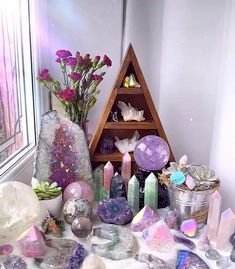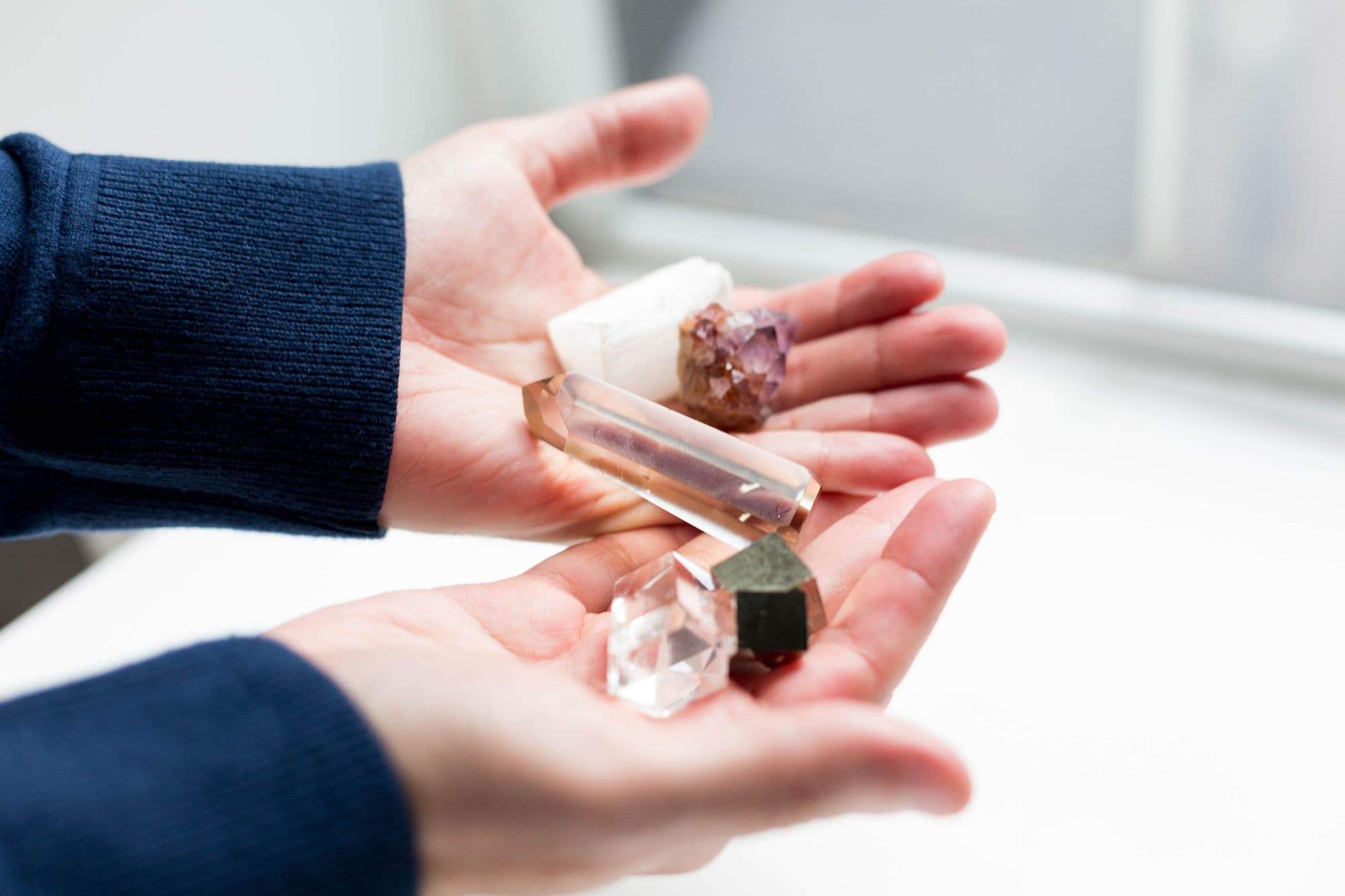Top Crystals for Balance in Mind, Body & Spirit — Meanings, Uses & How-To
Discover the best crystals for balance in mind, body & spirit. Learn meanings, uses, and how to choose stones for grounding, protection, and harmony.

Black Tourmaline is a grounding crystal valued for its protective and balancing qualities. Many people keep it near doorways, carry it during the day, or use it in stressful situations to feel more secure. Its iron-rich structure gives it a dense, steady energy, and geologists note that it can even hold an electrical charge when heated (a property called pyroelectricity). This unique mix of science and symbolism supports its role as a shield against negative energy.
Finding calm and stability in today’s busy world can feel challenging, which is why more people are turning to natural tools for support. In the U.S., one growing trend is the use of crystals for balance, with stones like amethyst, rose quartz, and black tourmaline believed to encourage focus, emotional harmony, and grounding. National surveys show that nearly 40% of American adults have tried practices such as meditation, yoga, or energy-based wellness, and crystals are often a part of those routines. Whether you’re curious about their history, want to know how to use them in everyday life, or are simply exploring new approaches to self-care, learning about crystals can be both enjoyable and meaningful. ➤ In this article, we are going to explore the top crystals for balance, learn their meanings, understand how they are used, and discover simple ways to bring them into your daily life for protection, grounding, and emotional harmony.
1. What Does Balance Really Mean?

Image source: i.pinimg.com
Balance isn’t about living a perfect life without stress—it’s about finding a steady middle ground between pressure and peace, work and rest, and the many emotions that come with daily challenges. When people talk about balance, they often mean feeling grounded, calm, and centered in both mind and body. This sense of stability can make it easier to handle stress, stay focused, and maintain healthier relationships.
Many people turn to crystals for balance as gentle reminders of these goals. Stones like amethyst, rose quartz, or black tourmaline are often kept in the home, carried in a pocket, or worn as jewelry to promote a sense of harmony and emotional stability. While crystals are not a replacement for medical care or professional therapy, they can be used as part of a personal self-care routine—serving as grounding stones for stress relief and daily rituals that support emotional balance.
To better understand how these two aspects of well-being work together, check out our complete guide on the difference between mental and emotional health.
2. Why People in the U.S. Turn to Crystals for Balance

Image source: i.pinimg.com
In the U.S., more and more people are exploring natural and holistic ways to manage stress and improve well-being. From yoga studios and meditation centers to online shops and even large retailers, crystals have become a visible part of the self-care movement. Surveys from wellness industry research show steady growth in the alternative healing market, and crystals are one of the areas driving this interest. Many Americans say that simply holding a stone, placing it nearby during meditation, or keeping it on a desk helps them slow down and stay present in the moment.
Healing crystals for balance and protection are especially popular because they connect to everyday needs—reducing stress, encouraging mindfulness, and supporting emotional health. Whether it’s amethyst for calm, rose quartz for compassion, or black tourmaline for grounding, people find comfort in using these stones as small but meaningful tools to feel more centered in busy modern life.
3. The Science vs. Belief Around Crystals

Image source: i.pinimg.com
It’s important to be clear: so far, there is no scientific evidence that crystals can directly heal the body or restore physical energy. Instead, their influence is often explained through belief, symbolism, and mindfulness practices. When someone chooses to work with crystals for stress and balance, the act of holding a stone, setting an intention, or meditating with it can serve as a calming ritual. Psychologists often link this to the placebo effect, where expectations and mindset shape how we feel.
Research on mindfulness supports this idea. Studies highlighted by the National Institutes of Health (NIH) show that simple rituals—such as pausing, focusing, or engaging with a symbolic object—can reduce perceived stress and improve emotional well-being. In this sense, crystals may not “fix” problems scientifically, but they provide a tangible reminder to slow down and focus on balance, which many people find genuinely helpful. For some, this combination of ritual and meaning is more than enough reason to keep crystals in their wellness routine.
4. History of Crystals for Balance Across Cultures
Image source: encrypted-tbn0.gstatic.com
Crystals have been valued across cultures for thousands of years, often connected with protection, healing, and spiritual balance. In Ancient Egypt, for example, lapis lazuli was carved into amulets and scarabs, believed to support wisdom and clarity—artifacts of which can still be seen in museum collections today. In China, jade has held deep cultural importance for over 5,000 years, symbolizing prosperity, longevity, and harmony of the body and spirit. Indigenous peoples in North America also worked with stones such as turquoise and obsidian, using them in rituals, jewelry, and tools to strengthen their connection with the Earth and promote grounding energy.
These cultural practices show that the idea of using healing crystals for balance is not new but rooted in long-standing traditions. Today in the U.S., many people draw inspiration from these histories, adapting crystals into modern wellness routines for stress relief, mindfulness, and emotional stability. By combining cultural wisdom with contemporary self-care, crystals for balance continue to carry meaning as both symbolic and practical tools for well-being.
5. Amethyst: The Stone of Calm

Image source: i0.wp.com
Amethyst is one of the most widely recognized crystals for balance and stress relief, loved for its soothing purple hues. For centuries, it has been associated with calmness, mental clarity, and emotional stability. Many people keep an amethyst crystal by their bedside to encourage more restful sleep, or carry a small stone during stressful days as a reminder to stay centered. In the U.S., amethyst jewelry—especially rings and pendants—is popular not just for its beauty but also for its symbolic meaning of peace and protection.
From a geological perspective, amethyst is a variety of quartz, which makes it both durable and relatively affordable compared to other gemstones. Its striking color comes from trace amounts of iron and natural irradiation, a fact gemologists often highlight when explaining its appeal. While scientific research does not confirm healing properties of amethyst, many wellness practitioners believe it can support mindfulness and emotional balance. Whether you view it as a powerful spiritual tool or simply admire its natural beauty, amethyst remains one of the most trusted crystals for promoting calm and inner harmony.
6. Rose Quartz for Emotional Balance
Image source: encrypted-tbn0.gstatic.com
Rose Quartz is often called the “stone of unconditional love,” and it’s one of the most recognized crystals for emotional balance and heart healing. Its soft pink hue is linked with qualities such as compassion, forgiveness, and emotional recovery, making it a favorite among those who want to invite more kindness and harmony into their lives.
Many people use rose quartz during meditation or mindfulness sessions when they want to release anger, calm anxious thoughts, or open themselves up to greater self-acceptance. In the U.S., it’s also one of the most gifted crystals, often exchanged between friends, partners, or family members as a symbol of love and peace. You’ll find it in many forms, including polished stones, bracelets, pendants, and even rose quartz water bottles that people use as a reminder of self-care.
Wellness coaches and mindfulness practitioners sometimes suggest rose quartz as a physical anchor for self-compassion—holding or wearing it can serve as a gentle cue to practice patience with yourself and others. Because of its affordability and availability, it’s considered one of the most accessible healing crystals for love, relationships, and emotional balance.
7. Clear Quartz: The Amplifier

Image source: images.squarespace-cdn.com
Clear Quartz is often called the “master healer” crystal because many believe it can amplify energy, focus, and intentions. People turn to clear quartz when they want to sharpen mental clarity, improve concentration, or bring a sense of order during stressful times. For balance, clear quartz is frequently paired with other crystals, as it is thought to strengthen and magnify their effects. Many people in the U.S. keep a piece on their work desk for focus, place it on meditation altars for mindfulness, or wear it as jewelry to carry its symbolic energy throughout the day. Its transparent, glass-like beauty makes it versatile and easy to integrate into any environment.
Beyond its spiritual symbolism, clear quartz also has a remarkable scientific side. Geologists classify it as a piezoelectric crystal, meaning it can produce a small electrical charge when placed under pressure. This property is why quartz is used in everyday technology such as watches, radios, and precision instruments. While this doesn’t prove its metaphysical reputation, it adds an intriguing scientific layer to the clear quartz meaning and uses, reinforcing why it is often described as a powerful amplifier of both energy and intention.
If you’re seeking comfort and spiritual strength in difficult times, explore our guide on Prayer for Mental Health: 12 Powerful Prayers, Scriptures & Guidance for Emotional Healing
8. Moonstone: For Intuition and Stability

Image source: www.rosecjewels.com
Moonstone is widely recognized as a crystal for intuition, emotional balance, and spiritual growth, making it a favorite among people who seek clarity during times of change. Its soft, glowing appearance is created by a natural optical effect called adularescence, a shimmer that reflects light across the surface of the stone. As a member of the feldspar mineral group, moonstone’s luminous quality is what gives it a reputation for being mystical and calming.
Historically, moonstone has appeared in cultural traditions around the world. In ancient Rome, it was associated with the moon goddess and thought to bring wisdom, while in India it was considered a sacred stone of love and protection. It also earned the nickname “traveler’s stone,” as it was believed to safeguard those on physical journeys and provide guidance through symbolic life transitions.
Today, moonstone remains popular both for its beauty and its symbolic meaning. In the U.S., moonstone jewelry is a growing trend—not only as a stylish accessory but also as a crystal for emotional stability, feminine energy, and spiritual intuition. Many people keep moonstone by their bedside to promote restful sleep, emotional grounding, and inner harmony, while others carry it as a reminder of patience and resilience during life’s ups and downs.
9. Black Tourmaline: The Protector
Image source: encrypted-tbn0.gstatic.com
Black Tourmaline is widely regarded as one of the most powerful grounding stones. For centuries, people have turned to it for protection, balance, and stability. Today, it’s often used to create a sense of safety by blocking unwanted energy and easing stress. Many people in the U.S. keep a piece near their front door, place it on a work desk, or carry it in a pocket or bag as a daily shield. Crystal practitioners frequently describe it as a “protective barrier,” and even those who are skeptical admit that its deep black color and solid feel give it a strong, reassuring presence.
From a geological perspective, black tourmaline (also known as schorl) is rich in iron, which contributes to its dark tone and heavy, grounding quality. This density may help explain why people naturally associate it with strength and resilience. The healing properties of black tourmaline—particularly its role as a grounding crystal for protection and balance—make it a top choice for those seeking stability in their everyday lives.
Did You Know? Black Tourmaline has a unique scientific trait called pyroelectricity—it can hold an electrical charge when heated or rubbed. While this property is used in scientific applications, many believe it symbolically reflects the stone’s reputation for repelling negative energy. This blend of science and symbolism makes black tourmaline one of the most sought-after crystals for balance and protection in the modern wellness world.
10. Jade: Harmony and Prosperity

Image source: m.media-amazon.com
Jade has been treasured for thousands of years, especially in Chinese and Mesoamerican cultures, where it was seen as a symbol of wisdom, harmony, and prosperity. In the U.S. today, jade is equally admired both for its beauty and for the belief that it encourages balance between mind, body, and spirit. Many people turn to jade stone for balance because it is thought to promote emotional stability and attract positive energy. Others keep jade in their homes or wear it as bracelets and pendants, associating the stone with prosperity, good fortune, and protection.
Beyond spiritual and cultural meanings, jade’s natural appeal comes from its soothing green shades, which are often linked to growth, renewal, and peace. Its durability also makes it a favorite in both fine jewelry and everyday wellness practices. For those exploring the healing properties of jade, it is often recommended as a supportive crystal for balance, calmness, and creating a sense of harmony in daily life.
11. Hematite: Grounding Energy
Image source: encrypted-tbn0.gstatic.com
Hematite is a dark, metallic-looking stone that has long been valued as a grounding crystal. Many people turn to hematite during stressful times when they feel scattered, anxious, or emotionally drained. Known for its stabilizing energy, hematite is often associated with strength, resilience, and a sense of inner balance. Crystal enthusiasts believe that its high iron content contributes to its reputation for providing stability, as iron itself is linked to strength and grounding in both cultural symbolism and physical reality.
In the U.S., hematite rings and bracelets have become especially popular because they are affordable, stylish, and easy to wear every day. Many people say that the natural weight of hematite jewelry offers a gentle physical reminder to stay steady, calm, and centered when life feels overwhelming. For those seeking healing properties of hematite, this stone is commonly used in meditation, grounding practices, and as a protective crystal to help block negativity and restore balance in both mind and body.
12. Chakra Connections for Balance

Image source: cdn.shopify.com
Many people believe that crystals can work with the body’s energy centers, known as chakras, to support balance and well-being. In this approach, different stones are thought to resonate with specific points along the body. For example, grounding crystals like hematite and black tourmaline are often linked to the root chakra, which is connected with stability and security. Rose quartz and jade are associated with the heart chakra, symbolizing love and emotional healing, while amethyst is connected with the crown chakra, representing clarity and spiritual awareness. Clear quartz is considered versatile, often used as an amplifier across all chakras to enhance the effects of other stones.
While chakra work is spiritual rather than scientific, it is commonly practiced alongside yoga, meditation, and breathwork. Surveys from organizations like Pew Research show that a growing number of Americans—especially younger adults—explore alternative wellness and spiritual practices outside traditional religion. For many, combining chakra balancing crystals with mindfulness routines provides a sense of harmony, grounding, and emotional balance in daily life.
13. How to Use Crystals for Balance at Home

Image source: media.istockphoto.com
Learning how to use crystals for balance at home is simple and flexible—you don’t need complicated rituals or special tools. Many people in the U.S. keep crystals on their nightstand to encourage restful sleep, place them in living rooms to create a calming atmosphere, or use them during yoga and meditation for focus and grounding. Some create a small “balance corner” with a few stones, a candle, and soothing items like plants or essential oils, turning it into a personal retreat space.
The most important step is to use your crystals with intention. Set a clear goal—such as managing stress, staying mindful, or promoting emotional harmony—and let the stones serve as daily reminders of that commitment. Whether you hold a crystal during meditation, keep one by your workspace for focus, or arrange several in a quiet corner of your home, these small practices can help reinforce balance and peace in everyday life.
If you’re curious about how coloring can support relaxation and emotional balance, check out our full guide on Coloring Pages for Mental Health: Benefits, Best Designs & How to Use
14. Crystals for Balance in Everyday Situations

Image source: energymuse.com
Different moments in daily life often call for different kinds of support, and crystals can be used as gentle reminders to stay grounded and calm. For workplace stress or mental fatigue, amethyst and hematite are often chosen because they are believed to encourage focus and reduce tension, making them popular crystals for balance and focus at work. In relationships, rose quartz and jade are commonly used as symbols of compassion and harmony, which is why many people keep them as crystals for emotional balance and love. When traveling, some carry black tourmaline as a protective grounding stone, believing it offers a sense of stability in unfamiliar environments. For rest, moonstone is a favorite; many place it on a nightstand or under a pillow as part of a crystal ritual for better sleep and emotional clarity.
By selecting crystals that match specific situations, you create small but meaningful practices that can bring calm and reassurance into your daily routine. Whether it’s a busy day at the office, a long trip, or moments of stress at home, these healing crystals for balance can serve as mindful tools to help you feel centered and supported.
15. Carrying and Wearing Crystals Daily

Image source: consciousitems.com
One of the simplest ways to keep the energy of crystals close is by wearing or carrying them throughout the day. Small tumbled stones for balance can easily slip into a pocket, wallet, or handbag, while crystal jewelry—such as bracelets, necklaces, or rings—keeps the stone in constant contact with your skin. Many people feel that this creates a steady reminder of their intention, whether it’s emotional stability, stress relief, or spiritual protection.
In the U.S., wearable crystals have become both a wellness practice and a popular fashion trend. For example, a rose quartz necklace for self-love and emotional balance can be worn daily, while a black tourmaline bracelet for protection and grounding is often chosen by those seeking stability during stressful times. Amethyst pendants, moonstone rings, and clear quartz bracelets are also common choices, blending symbolic meaning with personal style.
Beyond their metaphysical associations, crystals as jewelry are valued for their natural beauty, making them easy to integrate into everyday outfits. Whether worn for mindfulness, personal expression, or simply as an accessory, carrying crystals for balance and protection allows you to connect with their symbolism wherever you go.
16. Meditation with Crystals
Image source: encrypted-tbn0.gstatic.com
Meditation is one of the most popular and effective ways to work with crystals. Many people like to hold a stone in their hand, rest it on their chest, or place it nearby to create a calming space. The idea isn’t that the crystal itself performs magic, but rather that it acts as a focal point for intention and mindfulness. If your goal is to reduce stress, you might choose amethyst, often associated with calm and clarity. For focus and concentration, clear quartz is a common choice, while rose quartz can be used in meditation to encourage compassion and emotional balance.
Across the U.S., more meditation teachers and wellness circles are introducing crystals for meditation and balance as a way to make the practice feel more grounding. Beginners often find that having a physical stone helps them stay present, much like focusing on the breath or a mantra. Whether you’re sitting in silence, practicing guided meditation, or pairing crystals with yoga, using them in meditation can be a simple and meaningful way to support your mental and emotional well-being.
17. Cleansing and Charging Crystals
Image source: encrypted-tbn0.gstatic.com
Many people believe that crystals absorb the energy around them, which is why cleansing and charging crystals has become a common part of crystal care. These practices are less about removing something “bad” from the stone and more about creating a fresh start for your own intentions. Some of the most popular methods include rinsing certain stones under cool running water, placing crystals in direct moonlight (especially during a full moon), or using natural elements such as sage smoke, incense, or sound vibrations from a singing bowl.
Not all crystals are safe for every method—stones like selenite, malachite, or hematite should not be submerged in water because they can dissolve or rust. Sunlight can also fade some stones, such as amethyst and rose quartz, if left out too long. For this reason, moonlight is one of the most widely used and gentle options in the U.S. wellness community.
Ultimately, whether or not you believe in the energetic benefits, taking time to cleanse and charge crystals for balance can be a mindful ritual. It gives you a moment to pause, set intentions, and reconnect with your goals—turning the process into a form of self-care that’s as much about resetting yourself as it is about refreshing your stones.
18. Caring for Crystals Beyond Cleansing

Image source: i.pinimg.com
Cleansing is just the first step in looking after your crystals. Many stones are surprisingly delicate, and proper care helps preserve both their appearance and their symbolic meaning. For instance, the Gemological Institute of America (GIA) notes that amethyst can lose its vibrant purple color if it sits in direct sunlight for long periods, while soft minerals like selenite can dissolve when exposed to water. Even harder stones, such as quartz or jade, can get scratched if stored loosely with other crystals.
To keep them safe, many people in the U.S. use small pouches, velvet-lined boxes, or dedicated display shelves. Avoiding contact with household chemicals and storing crystals in a cool, dry place can also extend their lifespan. Some wellness shops even provide crystal care tips on cards included with purchases, reminding buyers to handle stones gently.
Taking the time to learn how to care for healing crystals not only protects your investment but also strengthens your personal connection to them. By storing crystals safely and handling them with mindfulness, you ensure they remain beautiful, meaningful, and effective companions in your journey toward balance and grounding.
19. Ethical and Environmental Considerations

Image source: i.pinimg.com
Crystals may be admired for their beauty and healing symbolism, but it’s important to remember that most stones are mined from the earth, and the process can carry environmental and ethical concerns. Reports have highlighted that large-scale mining in countries such as Madagascar and Brazil—two of the world’s biggest suppliers of quartz and tourmaline—can sometimes involve unsafe working conditions and ecological damage. These realities have sparked growing conversations in the U.S. wellness community about the importance of buying ethically sourced crystals.
If you’re interested in using crystals for balance, one way to practice mindful consumption is to support sellers who prioritize fair trade, sustainable mining, or recycled stones. Some retailers now provide transparency about where their crystals come from, and others specialize in sourcing directly from small-scale miners who follow eco-friendly methods. Choosing sustainable crystals not only allows you to enjoy their symbolism and beauty, but also supports better practices for the environment and fair treatment of workers. By being conscious of where your healing stones come from, you align your practice of balance with a more responsible and compassionate approach.
Not sure where to begin? Our Guided Meditation for Beginners: Complete Step-by-Step Beginner’s Guide will walk you through everything step by step
20. Creating a Daily Ritual with Crystals
Image source: encrypted-tbn0.gstatic.com
Crystals often have the most impact when they’re woven into everyday habits rather than used once in a while. A simple daily crystal ritual might include holding a grounding stone like black tourmaline during your morning meditation, keeping a clear quartz on your work desk to encourage focus, or placing a soothing amethyst by your bedside to promote relaxation at night. These small practices can serve as gentle reminders to pause, breathe, and realign your intentions throughout the day.
For many people in the U.S., adding crystals for balance and grounding to their routine is less about superstition and more about mindfulness. Carrying a crystal in your pocket or wearing it as jewelry can act as a personal symbol of calm during stressful moments. By consistently using crystals in ways that fit your lifestyle, you create a steady rhythm of self-care that supports emotional steadiness, mental clarity, and a sense of spiritual grounding over time.
21. Beginner’s Crystal Starter Kit for Balance

Image source: m.media-amazon.com
If you’re just beginning your journey with crystals, starting with a small and practical set is the easiest way to learn without feeling overwhelmed. A crystal starter kit for beginners usually includes four or five versatile stones that cover the most common needs for balance, protection, and emotional support:
-
Amethyst – often used to encourage calmness and reduce stress, making it a great choice for meditation or winding down at the end of the day.
-
Rose Quartz – known as the stone of compassion, it’s associated with emotional healing, self-love, and building positive relationships.
-
Clear Quartz – sometimes called the “energy amplifier,” it is valued for focus, clarity, and enhancing the effects of other crystals.
-
Hematite – a grounding stone linked with stability and strength, useful when you’re feeling scattered or anxious.
-
Black Tourmaline – widely recommended for protection, many people keep it nearby to feel secure and shielded from negative energy.
These healing stones for balance and grounding form a well-rounded beginner’s kit and are widely available in the U.S. through wellness shops, online retailers, and local metaphysical stores. Starting with these five crystals helps beginners explore the symbolic and meditative benefits of crystal use without investing in a large or confusing collection. Over time, you can add more specialized stones that match your personal goals and experiences.
22. Comparing Popular Crystals for Balance

Image source: lunatide.com
Choosing the right stone can feel overwhelming, especially with so many options available. To make it easier, here’s a clear comparison of some of the best crystals for balance and harmony, along with their main meanings, common uses in the U.S., and natural colors. This table can help you decide which crystal might be the most useful for your needs—whether you’re looking for emotional healing, grounding, or clarity in daily life.
Comparison of Common Crystals for Balance
|
Crystal |
Main Meaning |
Common Uses in the U.S. |
Color |
|
Amethyst |
Calm, clarity, relaxation |
Popular for stress relief, meditation, and as a sleep aid |
Purple |
|
Rose Quartz |
Love, compassion, emotional healing |
Used for relationships, forgiveness, and heart chakra healing |
Pink |
|
Clear Quartz |
Focus, energy amplification, clarity |
Often placed on desks for concentration or used in meditation to boost intentions |
Clear/transparent |
|
Moonstone |
Intuition, emotional stability |
Common in jewelry, meditation for insight, and used for stress balance |
Milky white/iridescent |
|
Black Tourmaline |
Protection, grounding, safety |
Kept near entryways, carried for protection, or used during stressful times |
Deep black |
|
Jade |
Harmony, prosperity, balance |
Worn as bracelets, feng shui practices, or given as gifts for luck |
Green (light to dark) |
|
Hematite |
Strength, grounding, stability |
Popular in rings, bracelets, and as a grounding stone during stress |
Metallic gray/silver |
23. Cost of Crystals in the U.S.

Image source: i.pinimg.com
When exploring crystals for balance, many people also want to know how much they typically cost in the U.S. market. Prices can vary depending on the size, quality, and whether the stone is polished, raw, or made into jewelry. On average, small tumbled stones or pocket-sized pieces are the most affordable, while larger polished specimens or decorative items cost more. Below is a look at the average retail prices of popular balancing crystals in 2025, based on U.S. wellness shops and online retailers.
Average Crystal Prices for Balance (U.S. 2025)
|
Crystal Type |
Average Cost (per piece) |
Typical Size/Notes |
|
Amethyst |
$15 – $40 |
Small clusters or palm stones; higher-end geodes can cost much more |
|
Rose Quartz |
$10 – $30 |
Tumbled stones and small carvings are common in this price range |
|
Clear Quartz |
$8 – $25 |
Widely available; larger polished points may range higher |
|
Moonstone |
$20 – $50 |
Jewelry-grade rainbow moonstone tends to be at the upper end |
|
Black Tourmaline |
$12 – $35 |
Rough chunks or pocket stones; polished spheres cost more |
|
Jade |
$25 – $70 |
Genuine jade varies widely; higher-quality pieces exceed this range |
|
Hematite |
$5 – $15 |
Affordable and widely available, often sold as rings or bracelets |
Source: Pricing compiled from major U.S. crystal retailers and online marketplaces (2024–2025).
Tip: If you’re just starting a collection, many U.S. shops sell crystal starter kits with 4–6 stones for balance (amethyst, rose quartz, clear quartz, hematite, and black tourmaline) at prices ranging from $25 to $60. This is often more cost-effective than buying each piece individually.
Discover more comforting Scriptures for a safe journey and travel confidently with God’s promises.
Conclusion
Finding balance in life is something everyone strives for, and using healing crystals for balance can be a meaningful way to support that journey. Amethyst is often chosen for calm and clarity, rose quartz is known for emotional healing and compassion, and black tourmaline is valued as a grounding crystal for protection. While there is no scientific proof that crystals physically heal, they can serve as powerful symbols and daily reminders to slow down, breathe, and center yourself. Many people in the U.S. use these stones as part of mindfulness, meditation, or simple self-care rituals, and the act of working with them often encourages reflection and calm. By making space for crystals in your life—whether on a desk, in your pocket, or during meditation—you create small, intentional habits that bring greater stability, peace of mind, and emotional harmony.
FAQs
Q: What are the best crystals for balance?
A: Amethyst, rose quartz, and black tourmaline are among the most popular choices for promoting balance in mind, body, and spirit.
Q: How do I use crystals for balance?
A: You can carry them in your pocket, wear them as jewelry, place them in your home, or meditate with them. The goal is to use them as symbols for your intentions.
Q: Do crystals for balance really work?
A: Scientifically, there’s no evidence they physically heal, but many people find comfort, calm, and mindfulness through using them.
Q: How often should I cleanse my crystals?
A: Most people cleanse their crystals once a month, especially during a full moon. Others do it whenever the stones feel “heavy” or less effective.
Q: Where can I buy crystals in the U.S.?
A: Crystals are widely available at wellness shops, online retailers, and even local markets. For balance, choose responsibly sourced stones whenever possible.

 Selina Smith
Selina Smith 













